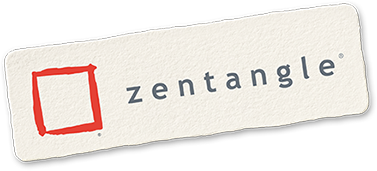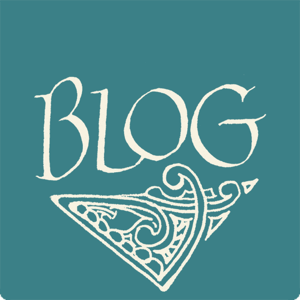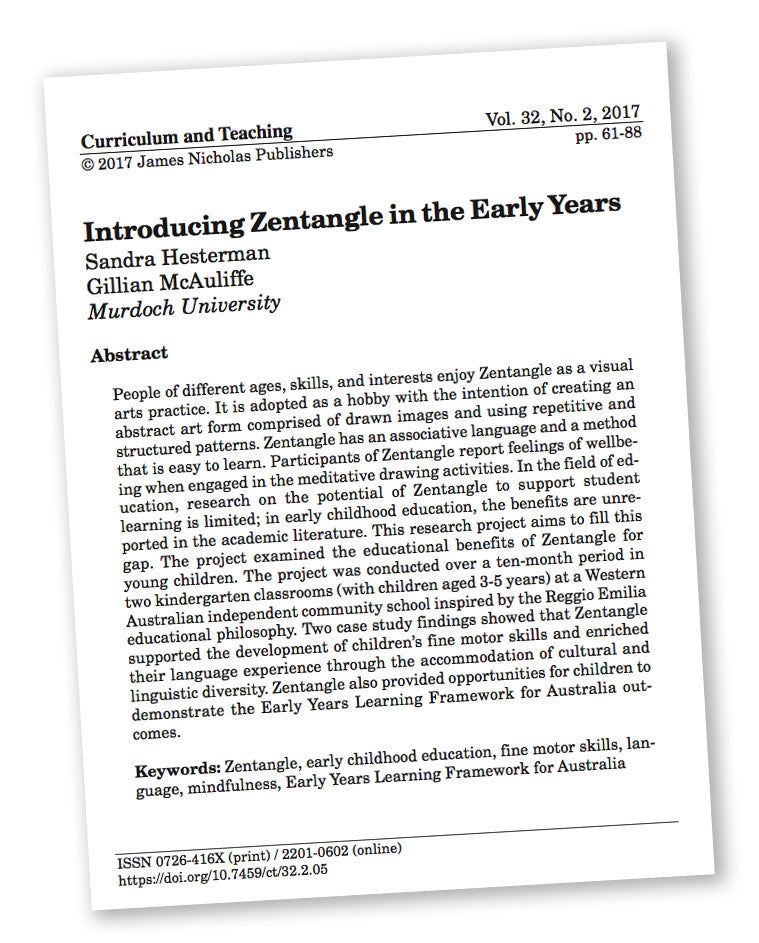Introducing Zentangle in the Early Years, is a peer reviewed study by Gillian McAuliffe, CZT and Sandra Hesterman. It evaluates five outcomes of a Zentangle practice for children during early development.
We first met Gillian McAuliffe when she travelled from Perth, Austraia to attend a Certified Zentangle Teacher (CZT) seminar. We hold our CZT seminars in the United States in the state of Rhode Island, which is about as far from Perth as you can get.
We asked Gillian why she would travel so far to come to seminar. She told us she was school Principal in Perth. She had a student who had suffered from a debilitating issue for several years. After she learned about the Zentangle Method, Gillian decided to use it at her next meeting with the student. She thought that, instead of a continuation of failed attempts at conversation, they might at least draw together.
At their next meeting, each sat with a tile and, with her guidance, they tangled (drew Zentangle art) together. During their first tile, such a significant breakthrough occurred that Gillian decided she had to come to seminar. She needed to understand what was behind the healing that occurred in that moment of creative silence that the Zentangle Method made possible.
Since Gillian’s return to Australia, she has implemented and tested the Zentangle Method at various levels of the Perth school system, all with significant and measurable success.
-----+-----
We used to say, “If you can sign your name, you can create Zentangle art.” But this study focuses on 3 – 5 year old children and turns that quote around to, “If you can create Zentangle art, you can sign your name.” In fact, this study found that a Zentangle practice was a preferred way to develop the fine motor skills necessary for good penmanship.
This is a published study and we cannot reproduce it here in full. We excerpt the abstract, conclusion and a few quotes within fair use guidelines so you can understand the scope of the study and some of its key points. You can download the complete 23-page study directly from the publisher here for $AUS40.
This is the first published peer reviewed study about the Zentangle Method.
Thank you and congratulations, Gillian!
-----+-----
Introducing Zentangle in the Early Years
Sandra Hesterman
Gillian McAuliffe
Murdoch University
[In this study, “Zentangle” refers to “The Zentangle® Method.”]
Abstract
People of different ages, skills, and interests enjoy Zentangle as a visual arts practice. It is adopted as a hobby with the intention of creating an abstract art form comprised of drawn images and using repetitive and structured patterns. Zentangle has an associative language and a method that is easy to learn. Participants of Zentangle report feelings of wellbeing when engaged in the meditative drawing activities. In the field of education, research on the potential of Zentangle to support student learning is limited; in early childhood education, the benefits are unreported in the academic literature. This research project aims to fill this gap. The project examined the educational benefits of Zentangle for young children. The project was conducted over a ten-month period in two kindergarten classrooms (with children aged 3-5 years) at a Western Australian independent community school inspired by the Reggio Emilia educational philosophy. Two case study findings showed that Zentangle supported the development of children’s fine motor skills and enriched their language experience through the accommodation of cultural and linguistic diversity. Zentangle also provided opportunities for children to demonstrate the Early Years Learning Framework for Australia outcomes.
Keywords: Zentangle, early childhood education, fine motor skills, language, mindfulness, Early Years Learning Framework for Australia outcomes.
[ . . . ]
Conclusion
Through the lens of the Early Years Learning Framework, Zentangle events were studied over a ten-month period to ascertain if Zentangle provided opportunities for children to demonstrate the five outcomes. The findings were conclusive and affirmative. Zentangle can extend and enrich children’s learning to achieve these outcomes and more. It is a developmentally appropriate practice that supports children in acquiring early fine motor writing skills through creative encounters, and it is an alternative to costly commercial products. At the heart of Zentangle in early childhood education is experiential learning and a state of mindfulness that can maximise potential to explore culturally constructed symbol systems, advance cultural competence, and refine cultural tools essential to thrive in an ever-changing and diverse world. The Zentangle® Method is worthy of consideration by teachers of young children as an approach that can support learning in myriad ways.
-----+-----
Here are several quotes from the study that give a sense of its scope:
“The potential benefits that the Zentangle® Method (hereafter also referred to as Zentangle) can bring to participants are impressive. Furthermore, the promotion of wellbeing and the development of each attribute and skill (identified above) are highly relevant to children in the early years of schooling. Central to this research study was one school’s endeavour to support the development of children’s penmanship without the use of standardised textbooks or the provision of template worksheets (which teachers and students deemed wearisome and dreary). “
[ . . . ]
“In addition to improved student concentration and fine motor skill performance, teachers observed that students engaged well in Zentangle. This included children identified with motor coordination difficulties, children on the autistic spectrum, and children recognised as having withdrawal and impulsive disorders. Teachers noted that participation in Zentangle promoted children’s wellbeing and boosted children’s confidence in their creative ability (by giving opportunities to express their thoughts and feelings while tangling/creating patterns for self-expression).”
[ . . . ]
“Zentangle has its own language that requires the synthesis of mathematical, artistic and cognitive challenges. It does not involve doodling aimlessly; rather, there is deliberate intention during a state of mindfulness. Its focus is on both process and product, but it also celebrates the encounter – an encounter that can develop relationships with the environment, enthuse symbolic invention, and inspire cultural courage and expressivity to identify new and better ways of learning (Giudici & Vecchi, 2004).”
[ . . . ]
“Children explored a selection of natural materials that made impressive marks and shapes (i.e. decorative pebbles, textured bark). New shapes were discovered when lines were joined together through mark-making. Children revised and extended their mathematical ideas and expressive language as they became more conscious of patterns and their arrangement in the natural environment.”
[ . . . ]
“As the year progressed, when children wanted to draw representational objects (i.e. a lion), they identified the shapes used to draw objects: transferring their Zentangle knowledge of how repeated use and arrangement of shapes, lines and patterns can unify different parts to form a whole. Zentangle became a creative force in their work.”
[ . . . ]
“During Zentangle, children developed fine motor skills at their own pace and initiated varied designs of meaning (through patterning) that simultaneously demonstrated their different interests, strengths and abilities: a negative cycle of frustration, fatigue, and fear of failure while learning to write (National Childcare Accreditation Council, 2008) was not observed.”
[ . . . ]
Outcome 1: Children have a strong sense of identity
- Children felt safe, secure, and supported when they openly expressed their feelings and ideas during Zentangle interactions with others and responded to ideas and suggestions from their teacher and peers.
- Children developed their emerging autonomy, resilience, and sense of agency when they demonstrated an increasing capacity for self-regulation during tangling experiences.
- Children developed knowledgeable and confident self-identities when they celebrated and shared their Zentangle contributions and achievements with others.
- Children learnt to interact with others with respect when they expressed their thoughts and views about their Zentangle designs (in relation to their lived experiences) and when they shared their emotions while re- flecting on how they felt about tangling.
Outcome 2: Children are connected with and contribute to their world
- [ . . . ]
- [ . . . ]
- [ . . . ]
Outcome 3: Children have a strong sense of wellbeing
- [ . . . ]
- [ . . . ]
- Children took increasing responsibility for their own wellbeing when they engaged in increasingly complex sensory-motor skills and movement patterns, and they demonstrated spatial awareness as they manipulated and managed tools with increasing competence and skill during Zentangle.
Outcome 4: Children are confident and involved learners
- [ . . . ]
- [ . . . ]
- [ . . . ]
- Children resourced their own Zentangle learning using natural and re- cycled materials and through using feedback from themselves and others to revise and build on a Zentangle idea.
Outcome 5: Children are effective communicators
- [ . . . ]
- [ . . . ]
- Children began to understand how symbols and pattern systems worked when they developed an understanding that Zentangle is a powerful means of communication: that ideas, thoughts and concepts can be rep- resented through symbols (and narratives of lived experiences associated with tangles/patterns).
- [ . . . ]
-----+-----
If you are involved in your own study of the Zentangle Method, we encourage you to acquire the full text of the study and cite it in your own study.
If you know of other studies regarding the Zentangle method, please let us know.
And once again, our thanks and appreciation to Gillian and Sandra.



Sophie on
i’m planing my research for my doctoral thesis on the effects on alleviating negative emotions by using Zentangle Method for adults/ elderly with depressive and anxiety symptoms. Gillian’s paper is really a good reference for me.
henri chan, czt18, from Hong Kong on
I work in a university library and have already recommended this article to three different students who were working on different research projects in very different subjects.
Melinda Isbell on
"
Anita Telkamp on
Leslie Hancock on
Stella Peters-Hessels on
Lorna on
Sandra Chatelain on
Hi! I’m currently working on my bachelor thesis, which I will do on the effects of Zentangle on primary school children. Does anyone have other researches on Zentangle? (Doesn’t have to be specifically in a school setting!) Contact me on iris-van-vliet@hotmail.com
Iris on
What fantastic research. It clarifies and puts inti context my observations and beliefs about the tremendous benefits of introducing Zentangle to children at an early age.
Joanna Quincey on
Mary Kay Watson on
Ing Frasch on